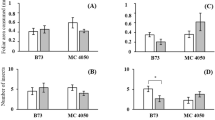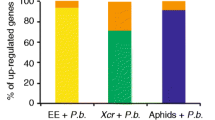Abstract
In nature, plants interact with multiple organisms, below and aboveground. Although interactions of plants with single biotic stressors are well characterized, knowledge of how the immune system responds to multiple biotic stressors is lacking. It is known that the two most important pathways involved in the plant immune defenses are jasmonic acid (JA) and salicylic acid (SA). The crosstalk between these plant hormonal signaling pathways seems to fine-tune the plant responses to different stressors. In this study, we characterized maize (Zea mays) hormonal interactions under the attack of two economically important pests: the bacterial pathogen that causes Goss’s bacterial wilt and leaf blight (Clavibacter michiganensis subsp. nebraskensis), and the chewing insect, fall armyworm (Spodoptera frugiperda). Our results indicate that the Goss’s wilt-resistant maize plants when pretreated with bacteria became more vulnerable to the subsequent attack by the fall armyworm larvae. Furthermore, plant hormone analysis demonstrated that the antagonistic interactions of JA-Isoleucine (JA-Ile), biologically active form of JA, and SA in maize plants contributed to enhanced plant susceptibility to herbivory. Collectively, our results suggest that plant hormonal interactions may play a major role in maize defense against multiple biotic stressors. Furthermore, this study will improve our understanding and ability to predict plant-induced hormone responses in an economically important crop.


Similar content being viewed by others

Data availability
Datasets generated and/or analyzed during the current study are available from the corresponding authors on reasonable request.
References
Ali JG, Agrawal AA (2012) Specialist versus generalist insect herbivores and plant defense. Trends Plant Sci 17:293–302
Bacher S, Friedli J, Schär I (2002) Developing in diseased host plants increases survival and fecundity in a stem-boring weevil. Entomol Exp Appl 103:191–195
Bonnet C, Lassueur S, Ponzio C, Gols R, Dicke M, Reymond P (2017) Combined biotic stresses trigger similar transcriptomic responses but contrasting resistance against a chewing herbivore in Brassica nigra. BMC Plant Biol 17:127
Chen MS (2008) Inducible direct plant defense against insect herbivores: a review. Insect Sci 15(2):101–114
Claflin LE, Bockelman DL, Shahin EA, Walter TL (1978) The effect of Corynebacterium nebraskense on corn yields. Phytopathol News 12:86
Doherty HM, Selvendran RR, Bowles DJ (1988) The wound response of tomato plants can be inhibited by aspirin and related hydroxy-benzoic acids. Physiol Mol Plant Pathol 33:377–384
Eichenlaub R, Gartemann K-H (2011) The Clavibacter michiganensis subspecies: molecular investigation of gram-positive bacterial plant pathogens. Annu Rev Phytopathol 49:445–464
Engelberth J, Viswanathan S, Engelberth MJ (2011) Low concentrations of salicylic acid stimulate insect elicitor responses in Zea mays seedlings. J Chem Ecol 37:263–266
Erb M, Reymond P (2019) Molecular interactions between plants and insect herbivores. Annu Rev Plant Biol 70:527–557
Ganiger PC, Yeshwant HM, Muralimohan K, Vinay N, Kumar ARV, Chandrashekara K (2018) Occurrence of the new invasive pest, fall armyworm, Spodoptera frugiperda (J.E. Smith) (Lepidoptera: Noctuidae), in the maize fields of Karnataka. India. Curr Sci 115:621–623
Grover S, Agpawa E, Sarath G, Sattler SE, Louis J (2020) Interplay of phytohormones facilitate sorghum tolerance to aphids. Plant Mol Biol. https://doi.org/10.1007/s11103-020-01083-y
Howe GA, Jander G (2008) Plant immunity to insect herbivores. Annu Rev Plant Biol 59:41–66
Hu Y, Ren J, Peng Z, Umana AA, Le H, Danilova T, Fu J, Wang H, Robertson A, Hulbert SH, White FF, Liu S (2018) Analysis of extreme phenotype bulk copy number variation (XP-CNV) identified the association of rp1 with resistance to Goss’s wilt of maize. Front Plant Sci 9:110
Jackson TA, Harveson RM, Vidaver AK (2007) Reemergence of Goss’s wilt and blight of corn to the central high plains. Plant Health Prog 8:44
Langemeier CB, Robertson AE, Wang D, Jackson-Ziems TA, Kruger GR (2017) Factors affecting the development and severity of Goss’s bacterial wilt and leaf blight of corn, caused by Clavibacter michiganensis subsp. nebraskensis. Plant Dis 101(1):54–61
Liu P, Xu Z-S, Pan-Pan L, Hu D, Chen M, Li L-C, Ma Y-Z (2013) A wheat PI4K gene whose product possesses threonine autophophorylation activity confers tolerance to drought and salt in Arabidopsis. J Exp Bot 64:2915–2927
Louis J, Shah J (2013) Arabidopsis thaliana—Myzus persicae interaction: shaping the understanding of plant defense against phloem-feeding aphids. Front Plant Sci 4:213
Martinez de Ilarduya O, Xie Q, Kaloshian I (2003) Aphid-induced defense responses in Mi-1-mediated compatible and incompatible tomato interactions. Mol Plant-Microbe Interact MPMI 16:699–708
Montezano DG, Specht A, Sosa-Gómez DR, Roque-Specht VF, Sousa-Silva JC, Paula-Moraes SV, Peterson JA, Hunt TE (2018) Host plants of Spodoptera frugiperda (Lepidoptera: Noctuidae) in the Americas. Afr Entomol 26:286–300
Moreira X, Abdala-Roberts L, Castagneyrol B (2018) Interactions between plant defence signalling pathways: evidence from bioassays with insect herbivores and plant pathogens. J Ecol 106:2353–2364
Nalam VJ, Louis J, Shah J (2019) Plant defense against aphids, the pest extraordinaire. Plant Sci 279:96–107
Pena-Cortés H, Albrecht T, Prat S, Weiler EW, Willmitzer L (1993) Aspirin prevents wound-induced gene expression in tomato leaves by blocking jasmonic acid biosynthesis. Planta 191:123–128
Pieterse CMJ, Van der Does D, Zamioudis C, Leon-Reyes A, Van Wees SCM (2012) Hormonal modulation of plant immunity. Annu Rev Cell Dev Biol 28:489–521
Riemann M, Dhakarey R, Hazman M, Miro B, Kohli A, Nick P (2015) Exploring jasmonates in the hormonal network of drought and salinity responses. Front Plant Sci. https://doi.org/10.3389/fpls.2015.01077
Schmelz EA, Alborn HT, Engelberth J, Tumlinson JH (2003) Nitrogen deficiency increases volicitin-induced volatile emission, jasmonic acid accumulation, and ethylene sensitivity in maize. Plant Physiol 133:295–306
Singh A, Li G, Brohammer AB, Jarquin D, Hirsch CN, Alfano JR, Lorenz AJ (2019) Genome-wide association and gene co-expression network analyses reveal complex genetics of resistance to Goss’s wilt of maize. G3 Genes Genomes Genet 9:3139–3152
Tabashnik BE, Carrière Y (2017) Surge in insect resistance to transgenic crops and prospects for sustainability. Nat Biotechnol 35:926–935
Thaler JS, Fidantsef AL, Duffey SS, Bostock RM (1999) Trade-offs in plant defense against pathogens and herbivores: a field demonstration of chemical elicitors of induced resistance. J Chem Ecol 25:1597–1609
Thaler JS, Fidantsef AL, Bostock RM (2002) Antagonism between jasmonate- and salicylate-mediated induced plant resistance: effects of concentration and timing of elicitation on defense-related proteins, herbivore, and pathogen performance in tomato. J Chem Ecol 28:1131–1159
Thaler JS, Agrawal AA, Halitschke R (2010) Salicylate-mediated interactions between pathogens and herbivores. Ecology 91:1075–1082
Thaler JS, Humphrey PT, Whiteman NK (2012) Evolution of jasmonate and salicylate signal crosstalk. Trends Plant Sci 17:260–270
Uknes S, Mauch-Mani B, Moyer M, Potter S, Williams S, Dincher S, Chandler D, Slusarenko A, Ward E, Ryals J (1992) Acquired resistance in Arabidopsis. Plant Cell 4:645–656
Varsani S, Grover S, Zhou S, Koch KG, Huang P-C, Kolomiets MV, Williams WP, Heng-Moss T, Sarath G, Luthe DS, Jander G, Louis J (2019) 12-Oxo-phytodienoic acid acts as a regulator of maize defense against corn leaf aphid. Plant Physiol 179:1402–1415
White RF (1979) Acetylsalicylic acid (aspirin) induces resistance to tobacco mosaic virus in tobacco. Virology 99:410–412
Züst T, Agrawal AA (2017) Trade-offs between plant growth and defense against insect herbivory: an emerging mechanistic synthesis. Ann Rev Plant Biol 68:513–534
Acknowledgements
We thank members of Everhart and Louis labs for their help with experiments and the Proteomic and Metabolomics Facility (Center for Biotechnology at the University of Nebraska-Lincoln) for the LC-MS assay and quantification of plant hormones. We also thank Drs. Tamra Jackson-Ziems and Ana María Vélez for comments on the draft of the article. This work was supported by funds from Agricultural Research Division and Department of Plant Pathology at the University of Nebraska-Lincoln.
Funding
Agricultural Research Division and Department of Plant Pathology at the University of Nebraska-Lincoln.
Author information
Authors and Affiliations
Contributions
KFDS, SEE and JL conceived and designed the research; KFDS performed the research; KFDS, SEE and JL analyzed the data; KFDS wrote the first draft of the manuscript and all authors reviewed and edited the manuscript.
Corresponding authors
Ethics declarations
Conflict of interest
The authors have no conflicts of interest to declare.
Additional information
Handling Editor: Chen-Zhu Wang.
Publisher's Note
Springer Nature remains neutral with regard to jurisdictional claims in published maps and institutional affiliations.
Rights and permissions
About this article
Cite this article
Da Silva, K.F., Everhart, S.E. & Louis, J. Impact of maize hormonal interactions on the performance of Spodoptera frugiperda in plants infected with Clavibacter michiganensis subsp. nebraskensis. Arthropod-Plant Interactions 15, 699–706 (2021). https://doi.org/10.1007/s11829-021-09849-x
Received:
Accepted:
Published:
Issue Date:
DOI: https://doi.org/10.1007/s11829-021-09849-x



